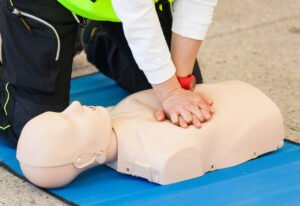
Employers must provide a safe working environment for their employees. There should be a written health and safety plan available for everyone to read and understand. Workplace safety is important, especially for those who work at construction sites or other places where they might come into contact with dangerous materials or machinery. To educate both employers and employees about some basics of workplace safety, this article provides a Workplace Safety 101.
How can you keep yourself healthy and safe in the workplace?
There are many hazards associated with working in a workplace environment. These include slips, trips, falls, burns, cuts, and even explosions. The Occupational Safety and Health Administration (OSHA) has strict rules regarding workplace safety. If you want to ensure that your workplace is safe, then you should follow these guidelines.

Here are some basic steps to ensure workplace safety.
1. Know the Rules
Before you start working, it’s best to know what the rules are. You can get this information from your employer or by contacting OSHA directly. They will be able to tell you about any laws that apply to your job.
2. Get Training
If you don’t already know how to work safely, then you need to learn. There are classes available through your local community college or vocational school that teach you everything you need to know about workplace safety. Some of these courses include:
- First Aid – This course teaches you how to treat minor injuries and illnesses. It also covers emergency procedures such as CPR and choking.
- Fire Fighting – This class teaches you how to prevent fires and extinguish them quickly.
- Hazardous Materials Management – This course teaches you about hazardous substances and how to avoid exposure to them.
3. Be Aware of Your Environment
You should always be aware of your surroundings when you are working. This means being aware of potential dangers such as power lines, moving parts, sharp objects, and other hazardous items. It also means knowing how to react in case something happens.
4. Practice Proper Procedures
Practice proper procedures befor using equipment. Make sure you understand how to operate all machines properly. Also, practice operating equipment such as drills, saws, ladders, etc., on a regular basis.
5. Keep Yourself Safe
Make sure that you keep yourself safe while working. Wear appropriate PPE, including gloves, boots, eye protection, and hearing protection. Don’t forget to put on your hard hat!
6. Report Problems
If you see anything unsafe or out of place, report it immediately. Do not try to fix problems yourself, but instead call someone else to help.
7. Stay Alert
Stay alert at all times. Take breaks regularly to avoid fatigue. Use common sense when doing tasks, and pay attention to warning signs.
8. Follow All Policies
Follow all policies set up by your employer. Remember that you are responsible for following all safety regulations.
9. Avoid Alcohol
Alcohol affects judgment, coordination, and reaction time. This makes it difficult to perform certain jobs safely.
10. Have Fun
Have fun while working. Enjoy your job and don’t let safety become a chore.
How can employers protect employees from workplace risks?
Employers have a legal duty to oversee the health and safety of their employees. This means that they must make sure that any risks, including workplace violence, are eliminated or reduced to protect the well being of everyone involved. To do this, employers need to have a written health and saftey policy in place that is made clear to all employees. Risks are identified as hazards. Hazards are controlled by implementing procedures and training. Procedures are written down and communicated to employees. Training is carried out when new workers join the company or after changes are made to the work environment.

To ensure that employees are protected from all risks, employers must follow certain guidelines. These include:
1. Identify Risks
The first step towards reducing or eliminating risk is identifying it. The more risks you identify, the easier it will be to eliminate them. You can use a risk assessment tool like OSHA’s Risk Assessment Tool to help you identify risks.
2. Control Risks
Once you have identified a risk, you need to control it. This involves controlling the amount of exposure to the risk. For example, if there is a chance that a worker could get hurt during a task, then you would want to reduce the chances of injury occurring. This may mean changing the way the task is performed or providing additional safeguards.
3. Eliminate Risks
Once you have controlled the risk, you need to eliminate it completely. This may involve changing the way the task works or replacing an item with one that is safer.
4. Reduce Risks
Finally, once you have eliminated the risk, you need to reduce it further. This may involve making the risk less likely to happen again. It also may involve taking steps to prevent future harm.
5. Record Results
You should record your results in a form called a “risk log”. This helps you track how effective your actions were in reducing or eliminating the risk. You should also record what happened during each incident so that you can learn from mistakes.
6. Communicate Results
It is important to communicate the results of your efforts to other people who might be affected by the risks. This includes communicating the results to management, co-workers, customers, and the public.
7. Review Processes Regularly
Your processes should be reviewed regularly. This ensures that they remain up to date and that they continue to be effective.
8. Make Changes When Necessary
If you find that your current procedures aren’t working, then you need to change them. This may involve updating policies or training materials.
9. Take Action After Incidents Occur
Take immediate action when someone gets injured or suffers property damage as a result of a safety violation. This lets you know that your procedures are working. It also lets you know which areas of your business require improvement.
10. Follow Up on Incidents
Follow up on incidents immediately after they occur. This gives you the opportunity to determine whether your procedures worked. If they didn’t, then you can take corrective action before something worse happens.
What incidents do employers have to report?
Employers must report certain types of incidents to OSHA. The most common ones are listed below.
1. Occupational Injury or Illness
An occupational injury or illness occurs when an employee gets hurt while working. Examples include slips, trips, falls, burns, cuts, bruises, sprains, strains, concussions, and poisonings.
2. Hazardous Conditions
A hazardous condition exists when an employer fails to provide a worker with a safe environment. Examples include poor lighting, slippery floors, exposed machinery, and high places.
3. Recordkeeping Violations
Recordkeeping violations occur when employers fail to keep records that would allow them to comply with OSHA regulations. Examples include not keeping records of injuries, illnesses, and deaths; not keeping records of safety programs; and not maintaining accurate records of work hours.
4. Failure to Pay Overtime Wages
Failure to pay overtime wages occurs when an employer pays less than time-and-a-half for hours worked over 40 per week.
5. Discrimination
Discrimination happens when an employer treats one person differently from others because of race, color, religion, sex, national origin, age, disability, sexual orientation, gender identity, veteran status, genetic information, or any other protected characteristic.
6. Retaliation
Retaliation refers to actions taken against an employee who has filed a complaint or otherwise protested discrimination.
7. Unfair Labor Practices
Unfair labor practices refer to actions taken against an employer by the National Labor Relations Board (NLRB). They include refusing to bargain collectively, threatening strike action, locking out employees, and failing to make required contributions to employee benefit plans.
8. Wage & Hour Law Violations
Wage and hour law violations are those that occur under the Fair Labor Standards Act (FLSA), which sets minimum wage standards, requires overtime pay, prohibits child labor, and establishes recordkeeping requirements.
9. Hazardous Substances
Hazardous substances are chemicals that pose a risk to human life if they come into contact with skin or eyes. Some examples of these substances include asbestos, benzene, formaldehyde, lead, mercury, silica dust, solvents, and vinyl chloride.
10. Sexual Harassment
Sexual harassment occurs when someone uses his or her power or authority to take advantage of another person sexually.
What are the benefits that injured employees may be entitled to receive?

Injured workers have several rights under federal law. These rights help protect their health and financial security in the event that they become ill or injured at work.
1. Workers’ Compensation Benefits
The first step toward receiving compensation is filing a claim with your state’s workers’ comp agency. This process usually takes about two weeks. Your employer must then send you a written notice stating what happened and why it was necessary to file a claim. You will also need to complete forms called “Authorization for Treatment” and “Report of Injury or Illness.” Once this paperwork is completed, your claim can begin.
2. Temporary Disability Insurance
If you are unable to return to work after being hurt on the job, temporary disability insurance provides income while you recover. The amount of coverage depends on how long you are off work. Coverage typically lasts three months unless you ask for more time. After that, you will need to apply again for additional coverage.
3. Long Term Disability Insurance
If you cannot perform your regular duties due to an injury or illness, long term disability insurance helps cover medical bills. It does not replace lost earnings but instead replaces a portion of your salary. To qualify for this type of coverage, you must meet certain criteria, such as having worked for your current employer for at least 20 years.
4. Life Insurance
Life insurance pays your family members if you die. There are different types of policies available, including whole life, universal life, variable life, and indexed universal life. Each type has its own advantages and disadvantages. Talk to your agent about which policy would best suit your needs.
5. Short-Term Disability Insurance
Short-term disability insurance covers your income during your recovery period. If you lose your job because of an injury, you can collect up to 60% of your average weekly wages per month.
6. Health Savings Accounts
Health savings accounts allow people to set aside money from each your income if you are temporarily disabled and cannot work. If you lose your job, you can continue to collect short-term disability payments until you find new employment. However, most employers require you to wait six months before collecting any money from this source.
7. Pension Plans
Pension plans provide retirement income to employees who have been working for many years. They are similar to 401(k) plans except that they do not offer tax breaks. Instead, pension funds are funded by contributions made by both the employee and the employer.
8. Social Security
Social security benefits range from $1,000 to $2,400 a month depending on your age and past wage history. People who were born between 1928 and 1938 may be entitled to higher benefits. Benefits increase every year based on inflation.
9. Unemployment Insurance
Unemployment insurance (UI) is paid directly to individuals when they lose their jobs through no fault of their own. UI ranges in length from 26 weeks to 99 weeks. Most states limit unemployment benefits to 52 weeks.
10. Other Types of Insurance
There are other types of insurance that can help protect your assets and pay out in case of emergencies. These include home owners insurance, renter’s insurance, car insurance, health insurance, and umbrella liability insurance.
What are the other legal responsibilities employers have regarding health and safety?
Every worker should know what his/her rights. You should know that there are laws that govern workplace safety. For example, OSHA regulates workplace safety and requires employers to follow certain rules. Employers also have a duty to provide workers with a safe place to work. This means that they need to make sure that all equipment and materials used in the workplace are safe. They also need to ensure that workplaces are free of hazards.
If an accident happens, then the injured party can file a lawsuit against the company responsible. The law allows workers to receive compensation for injuries sustained while performing their jobs. In addition, employers are required to provide workers with proper training and information so that they will understand how to avoid accidents.
You should always ask your supervisor or manager for advice about workplace safety. He/she might even give you some tips on how to stay safe at work.
What if the employer fails to keep the workplace healthy and safe?
In some cases, employers fail to comply with workplace safety regulations. When this occurs, it is called “negligence”. Negligence is when someone does something wrong without intending to harm anyone. It is usually unintentional.
When negligence takes place, the person who was harmed has the right to sue the negligent party. There are two ways to bring a lawsuit. First, the victim can take the matter to court. Second, he/she can go to arbitration. Arbitration is a process where a third-party decides whether or not the employer was negligent. If the arbitrator finds that the employer was negligent, then the victim gets money as compensation.
The victim must prove that the defendant had enough knowledge about the risks involved in the job. However, the victim cannot sue the employer for damages unless he/she proves that the employer knew about the danger but did nothing to prevent the injury.
How do I get compensated for workplace injuries?
In order to get compensation for workplace injuries, you must first prove that the employer was negligent. To do this, you must show that the employer failed to provide a safe working environment. Once you have proven that the employer was negligent and that you were hurt because of this negligence, you can collect financial compensation.
Compensation includes medical expenses, lost wages, and possibly future medical expenses.
How much can I expect to be paid for workplace injuries?
This depends on several factors such as the type of injury, the severity of the injury, the length of time the injury lasted, and the amount of time off from work. An experienced personal injury lawyer can help you determine how much you can expect to be paid.
Can I sue my boss for workplace injuries?
Yes! You can sue your boss if he/she caused your workplace injury. Your boss could be liable for causing your workplace injury. However, you must prove that he/she was negligent. This means that you must show that the boss knew about the risk of the injury occurring and that he/she did nothing to prevent the accident.
Your boss may try to argue that he/she was not negligent. Therefore, you should consider hiring a qualified attorney to represent you.
Have more questions about workplace health and safety?
If you want to learn more about workplace health and safety, please contact us today. Our office is located in North Carolina, but we serve clients throughout the entire state. Call us now at 1-800-319-9000 to schedule an appointment.









